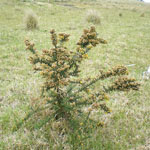Gorse
Common name:
- Gorse
Scientific name:
- Ulex europaeus L.
Other common name:
- Furze
Plant status (by Catchment Management Authority boundary)
Find your Catchment Management Authority
Regionally prohibited in East Gippsland CMA.
Regionally controlled in these CMA areas:
- Glenelg Hopkins CMA
- Goulburn Broken CMA
- North Central CMA
- North East CMA
- Melbourne Water (covering the Port Phillip and Western Port areas)
- West Gippsland CMA
- Wimmera CMA
Restricted
- Mallee CMA
Plant biology
Appearance
Shrub (or bush)
Description
Gorse is a perennial shrub up to 4m high and 3m diameter.
Stems
Gorse stems are green when young, turning brown and woody when mature.
All branches end in a green spine up to 5cm long, with deep grooves running along its length. Branches are hairy, covered with spines and short branchlets that terminate in spines.
Leaves
Gorse leaves are dark green and stalkless. They are narrow, stiff and 6 to 30mm long by 1.5mm wide with a wide sharp spine at the tip occurring in clusters along the branch.
Spines and leaves have a waxy coating and end in a sharp yellow point.
Flowers
Gorse flowers are bright yellow pea-like flowers of 15 to 25mm length with a distinct coconut-like fragrance.
Fruit
Fruit of gorse is in a fine, densely-hairy oblong pod 10 to 20mm long by 6mm deep.
The pods are green when they are young, turning into a dark brown pod when mature. The pods each contain 2 to 6 seeds.

Seeds
Gorse seed is 3 to 4mm across with a very hard green or brown seed coat and a white or yellow appendage.
Growth and lifecycle
Method of reproduction and dispersal
Gorse reproduces by seed.
Its seeds are hard and need some damage or scarification to the coat before they will germinate. This damage can be caused by fire, soil disturbance, insects, changes in soil moisture, being scraped by floodwaters or passing through an animal's stomach.
Gorse is spread by seed ejection, transportation of soil, sand or gravel, livestock, birds, ants and water.
Seeds mainly fall around the plant, but pods can explosively eject seed up to 5m during hot dry weather. Most seed is in the top 2.5cm of soil but can be to 15cm deep. Seed will not establish below 8cm of burial.
Rate of growth and spread
Germination occurs in autumn and spring and young plants flower at approximately 18 months of age.
Seedbank propagule persistence
Seed production is prolific and seeds remain viable for 30 to 50 years or more in the soil. Seed banks can be as high as 100 million seeds per hectare.
Preferred habitat
Gorse favours temperate regions with higher rainfall areas of 650 to 900mm annually.
The weed has been found growing in a wide range of soil types but ideally prefers low fertility, acidic soils.
Infestations are located along roadsides, creek banks, neglected areas and marginal forests.
Distribution
In Victoria, gorse has been recorded growing throughout the State, except for the Mallee and parts of Gippsland. The heaviest infestations are located in the Central Highlands around Ballarat.
Growth calendar
The icons on the following table represent the times of year for flowering, seeding, germination, the dormancy period of Gorse and also the optimum time for treatment.
| Jan | Feb | Mar | Apr | May | Jun | Jul | Aug | Sep | Oct | Nov | Dec | |
|---|---|---|---|---|---|---|---|---|---|---|---|---|
| Flowering | ||||||||||||
| Seedling | ||||||||||||
| Germination | ||||||||||||
| Dormancy | ||||||||||||
| Treatment |
Impact
Impact on ecosystems and waterways
Gorse competes with young trees and shrubs and hinders the growth of native understorey species. A long-term effect of the plant's presence is that the soil becomes more acidic and loses nutrients.
The weed can be found in:
- parks
- reserves
- riparian areas
- bushland fringe
- roadsides
- townships
- agricultural environments.
Agricultural and economic impacts
Gorse is a major weed of agriculture invading all pasture types and significantly reducing grazing capacity. It has the ability to exclude all other plants and greatly hinders access to stock and waterways.
Presence of this weed greatly reduces land value.
The plant is unpalatable to cattle and sheep. Horses will eat new growth while goats eat mature plants.
Gorse is a significant haven for rabbits, foxes, feral cats and mice.
Social value and health impacts
This weed is highly flammable and is a significant fire hazard. It also reduces visibility on roadsides, in some cases, displacing threatened species.
Management
Prescribed measures for the control of noxious weeds:
- application of a registered herbicide
- cultivation
- physical removal
- mulching.
Read about prescribed measures for the control of noxious weeds.
Other management techniques
Changes in land use practices and spread prevention may also support gorse management after implementing the prescribed measures.